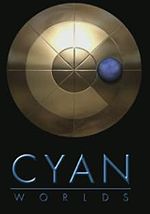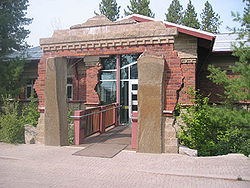- Cyan Worlds
-
Cyan Worlds, Inc. 
Type Privately held company Industry Video games Founded 1987 Founder(s) Rand Miller
Robyn MillerHeadquarters Mead, Washington, US Key people Rand Miller, CEO and Founder Products Myst and Uru series Employees 40 (2005) Website www.cyanworlds.com Cyan Worlds, Inc. (formerly Cyan, Inc.) is a video game development company, founded by brothers Rand and Robyn Miller in 1987, and best known as the creators of the Myst series. After Myst and its sequel Riven sold several million copies each, Cyan went on to create the massively multiplayer online adventure, Uru, which was cancelled and re-opened several times. To clarify new directions for the company, CEO Rand Miller changed the name from "Cyan" to "Cyan Worlds," after the release of Riven. The company is located in Mead, Washington, just outside Spokane.
Contents
History
Pre-Myst
Founded in 1987 by brothers Rand and Robyn Miller, Cyan originally produced adventure games for children. The company's early titles, The Manhole (1988), Cosmic Osmo and the Worlds Beyond the Mackerel (1989) and Spelunx (1991) were whimsical fantasy adventures for a young audience. The games offered numerous graphical screens with puzzles, mini-games and activities. Some of these titles were early forays of Cyan into both construction of interactive worlds using HyperCard, and the CD-ROM medium, both of which would later be used for Myst.
Myst franchise
In 1993, Cyan shot to worldwide fame with the release of Myst, a 3D pre-rendered adventure game aimed at an older audience unlike their previous games. Myst was one of the earliest CD-ROM games, in a time when CD-ROM drives were beginning to become mainstream. The title sold more than six million copies,[1] and was the best-selling PC game ever until The Sims exceeded its sales in 2002.[2]
With the revenue from Myst, Cyan quickly moved to a new headquarters to accommodate a bigger staff, where they remain today. During this time, three novels set in the Myst universe were co-authored by the Millers and David Wingrove. Riven: The Sequel to Myst, was released in 1997. This same year, company co-founder Robyn Miller left Cyan to pursue other interests, ten years after he began The Manhole.
The next eight years saw a huge amount of expansion in the Myst franchise, both from within and outside of Cyan. While the publishing rights were transferred from Brøderbund to Mattel, and then to Ubisoft, Cyan prepared for the next game in the Myst universe, which was to be a massively multiplayer online game, and not a direct sequel to Myst. During this time, the company changed its name to "Cyan Worlds". Partly as a test of their new real-time 3D engine, Cyan released realMyst in 2000, a complete recreation of the original Myst game. At the same time, the next Myst game, Myst III: Exile, was developed by Presto Studios and published by Ubisoft, and released in 2001.
In 2003, Cyan announced that their multiplayer adventure, Uru, formerly known under the working titles DIRT ("D'ni In Real Time"), Mudpie ("Multi-User DIRT – Persistent Interactive Environment"), Parable and Myst Online, would be split into separate single-player and multiplayer components, at the request of the publisher Ubisoft.[3] The single-player component, Uru: Ages Beyond Myst, was released later that year. The multiplayer component, Uru Live had a short beta test, but was cancelled before being officially released.
In 2004, Cyan released two Uru expansion packs (To D'ni and The Path of the Shell) that included content originally intended for the online component. The same year, Ubisoft independently developed and released Myst IV: Revelation, the second game in the series not developed by Cyan. In the following year, Cyan developed the final chapter in the Myst series, Myst V: End of Ages. After Myst V, the company laid off most of its employees due to financial difficulties,[4] but shortly after rehired almost everyone after negotiating a deal with Turner Broadcasting. Prior to this, the company was working on an as yet unannounced project (reportedly named Latus by Richard A. Watson) and negotiating with an undisclosed publisher, but its status is now unclear, though Rand Miller made mention of it in August 2011 and confirmed its name as Latus. [5]
Post-Myst
After Uru Live closed, fans began developing their own server software. In response to this demand, Cyan Worlds released Untìl Uru in late 2004, a modified version of the client and server software of Live. This version of the game was unsupported – servers were owned and operated by fans, and no new content was provided. Later, through funding by GameTap, Cyan managed to offer the "D'mala" shard, an official game server. Fans also began developing new content for the game, in an unofficial context.
In 2006, Rand Miller announced that Uru Live would return in full capacity using GameTap-hosted servers and funding. Cyan staff were re-hired and production of new Uru content began.[6]
Myst Online: Uru Live launched officially on GameTap on February 15, 2007, after being available through GameTap as an open beta for a few months. This was the most successful incarnation of Uru, finally achieving the original goal of supported online play, with ongoing content releases. Despite this success, GameTap announced on February 4, 2008, that it would be closing Uru Live. Game servers remained online for 60 days following, and were finally shut down on April 10, 2008.
On June 30, 2008, it was announced that Cyan Worlds had regained the rights to Uru, and had plans to relaunch it under the name Myst Online: Restoration Experiment. Cyan no longer has funds available for further development on the game, and instead intends to release the code for the servers, client and tools as open-source software,[7] and rely on user-generated content for expansion.
In November 2008, Cyan laid off about 50 game testers. The layoffs came as a result of the acquisition of their primary customer Gamecock Media.[8]
In February 2010, Cyan took steps towards opening up Uru, with the launch of a new Myst Online: Uru Live server (dubbed "MOULagain" by fans) with access to all of the Ages of Uru. They made the client software available free of charge and began accepting donations.[9] As of April 2010, over 22000 accounts have been created.[10]
On April 6, 2011, Cyan released the source code to the URU client as well its development tools.[11]
Other properties
On November 30, 2007, Cyan released Cosmic Osmo's Hex Isle via the online service Fanista. This marked the return of the Cosmic Osmo character after 15 years.
In August 2009, it was announced that Cyan Worlds would be working with Creative Kingdoms to create an online version of their MagiQuest virtual reality game.[12] MagiQuest Online makes use of the Plasma engine used in Myst Online: Uru Live.
Titles
Most of Cyan's titles (those in the Myst and Uru series) tell the story of a humanoid race called the D'ni, who have the ability to write linking books. Linking books teleport the user into other worlds, limited only by the imagination of the author. These worlds are referred to as "Ages." Cyan's games are known for their intricate plots, exquisite graphics, and immersive sounds. They focus on exploration and storytelling, presented by a simple, elegant interface that appeals to gamers and non-gamers alike. Related to the storyline of the D'ni are three Myst novels: The Book of Atrus, The Book of Ti'ana and The Book of D'ni.
Game Name Release Year Publisher The Manhole 1988 Brøderbund Cosmic Osmo and the Worlds Beyond the Mackerel 1989 Brøderbund Spelunx and the Caves of Mr. Seudo 1991 Brøderbund Myst 1993 Brøderbund Riven 1997 Red Orb Entertainment realMyst 2000 Mattel Uru: Ages Beyond Myst 2003 Ubisoft Uru: To D'ni 2004 Ubisoft Uru: The Path of the Shell 2004 Ubisoft Untìl Uru 2004 Self-published Myst V: End of Ages 2005 Ubisoft Myst Online: Uru Live 2007 GameTap Cosmic Osmo's Hex Isle 2007 Fanista Myst for iPhone and iPod Touch 2009 Self-published MagiQuest Online 2010 Creative Kingdoms The Manhole: Masterpiece Edition for iOS 2010 Self-published Riven for iPhone and iPod Touch 2010 Self-published Stoneship for iPhone, iPod Touch, and iPad 2010 Self-published Bug Chucker for iPhone, iPod Touch, iPad, and Android 2011 Self-published - Rand Miller, co-founder and CEO
- Robyn Miller, co-founder and former designer/director
- Richard Vander Wende, former designer/director
- Richard A. Watson, lead programmer and [in-universe] D'ni historian
- Ryan Miller
- Martin O'Donnell
See also
References
- ^ Guilofil, Michael (May 22, 2001). "Beyond the Myst". The Spokesman-Review. http://www.spokesmanreview.com/pf.asp?date=052201&id=s966647.
- ^ Walker, Trey (March 22, 2002). "The Sims overtakes Myst". GameSpot. http://www.gamespot.com/pc/strategy/simslivinlarge/news_2857556.html. Retrieved March 17, 2008.
- ^ Herold, Charles (March 4, 2004). "Tackling the Mystery of the Missing Game". New York Times: p. G5.
- ^ Myst Creator Cyan Worlds Folds
- ^ Mysterium 2011 Video Stream Chat
- ^ TXT: Cyan Worlds trying to reach the last age, or Myst, The Final Offer
- ^ "Cyan makes it official: "Myst" now in the hands of its fans". Spokesman Review. December 12, 2008. http://www.spokesmanreview.com/blogs/txt/archive/?postID=8731. Retrieved December 20, 2008.
- ^ Radd, David (November 5, 2008). "Cyan Lets 50 Game Testers Go". Spokesman Review. http://www.spokesmanreview.com/breaking/story.asp?ID=17571. Retrieved November 14, 2008.
- ^ "Myst Online: Uru Live Again". Myst Online: Uru Live. February 4, 2010. http://mystonline.com/en/about/news/. Retrieved March 18, 2010.
- ^ "CAVCON Meter". http://mystonline.com/forums/viewtopic.php?t=20014. Retrieved April 12, 2010.
- ^ http://mystonline.com/forums/viewtopic.php?t=24534
- ^ Kushner, David (August 24, 2009). "Real-Life WoW for the Chuck E. Cheese Set". Wired Magazine. http://www.wired.com/gaming/gamingreviews/magazine/17-09/pl_games. Retrieved November 29, 2009.
External links
Coordinates: 47°47′26″N 117°21′16″W / 47.790481°N 117.354308°W
The Myst franchise and related topics Myst games 
Uru games Novels and fiction Developers Categories:- Companies based in Washington (state)
- Video game companies of the United States
- Video game companies established in 1988
- Video game developers
- Privately held companies based in Washington
Wikimedia Foundation. 2010.

